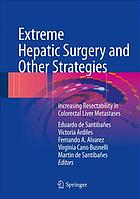مشاهده سبد خرید “Adverse Cutaneous Drug Reactions to Cardiovascular Drugs 2014” به سبد خرید شما اضافه شد.
Extreme Hepatic Surgery and Other Strategies: Increasing Resectability in Colorectal Liver Metastases 2017
دانلود کتاب پزشکی جراحی رادیکال کبد و سایر استراتژی ها: افزایش قابلیت برداشت در متاستازهای کبدی کولورکتال
ناشر:
Springer
| نویسنده |
Eduardo de Santibañes, Fernando A. Alvarez, Martin de Santibañes, Victoria Ardiles, Virginia Cano Busnelli |
|---|
| تعداد صفحهها |
383 |
|---|---|
| نوع فایل |
|
| حجم |
25 Mb |
| سال انتشار |
2017 |
89,000 تومان
دانلود ۳۰.۰۰۰ کتاب پزشکی فقط با قیمت یک کتاب و ۹۹ هزار تومان !
توضیحات
این کتاب به تشریح تشخیص ها می پردازد. مرحلهبندی و مدیریت بیماران مبتلا به متاستازهای کبدی کولورکتال که در ابتدا غیرقابل تشخیص تلقی میشدند و راهبردهای مختلف افزایش زندهمانی را همراه با تاکتیکها و راهکارهای آنها به تصویر میکشد. سرطان کولورکتال سومین نوع سرطان تشخیص داده شده در جهان است و طبق آمار اخیر سرطان سالانه حدود 1.23 میلیون بیمار تشخیص داده می شود. از این بیماران، حدود 50 درصد از این بیماران در طول دوره بیماری دچار متاستازهای کبدی می شوند و حدود 15 تا 25 درصد در هنگام تشخیص به مرحله چهارم مبتلا می شوند. هپاتکتومی به عنوان درمان انتخابی برای این بیماران شناخته شده است و نرخ بقای 5 ساله 50-60٪ و تنها امید برای درمان را ارائه می دهد. با این حال، در هنگام تشخیص، تنها 10-20٪ از این بیماران به احتمال زیاد می توانند تحت عمل جراحی با هدف درمان قرار گیرند. امکان دستیابی به رزکسیون R0 بارها توسط کمیت و کیفیت باقیمانده های کبدی (FLR) محدود می شود، با نارسایی کبدی پس از هپاتکتومی (PHLF) ترسناک ترین و جدی ترین عارضه پس از برداشتن بزرگ کبد است. در طول سالها، استراتژیهای مختلفی با هدف افزایش قابلیت برداشتن با افزایش باقیماندههای کبدی در آینده و/یا کاهش اندازه تومور، به عنوان مثال ALPS، توسعه یافتهاند. همراه با این تکنیکها، روشهای جراحی همزمان از جمله برداشتن چند احشایی ایجاد شدهاند که ظرفیت برداشتن را برای بیماران بیشتر میکند.
توضیحات(انگلیسی)
This book describes the diagnoses; staging and management of patients with colorectal liver metastases initially considered unresectable and portrays the different strategies to increase resectability along with their tactics and tricks. Colorectal carcinoma is the third most commonly diagnosed cancer in the world and according to recent cancer statistics around 1.23 million patients are diagnosed each year. Of these patients, approximately 50% will develop liver metastases during the course of their disease and around 15-25% are found to have stage IV disease at diagnosis. Liver resection has been recognized as the treatment of choice for these patients, offering overall 5-year survival rates of up to 50-60% and the only hope for cure. However, at diagnosis only 10-20% of these patients are possibly amenable to surgical resection with curative intent. The possibility to achieve an R0 resection is many times limited by the amount and quality of the future liver remnant (FLR), being posthepatectomy liver failure (PHLF) the most feared and severe complication after major liver resections. With the years, diverse strategies have been developed with the intention to increase resectability by increasing the future liver remnant and/or reducing tumor size, e.g. ALPPS. Along with these techniques, associated surgeries are developed including multivisceral resections, which broadens even more the resectability for patients.




